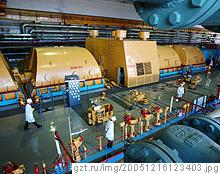
"The Chernobyl accident occurred during the routine shutdown of the 4th power generation unit of the ChNPP for regular maintenance. During such shutdowns, it is normal to carry out certain additional operations that could not be performed during the unitís operation under load. In that case, apart from the routine operations set forth by the equipment operating manuals, it was planned to check performance of the unitís systems under the Maximal Design basis Accident (MDA) conditions.
The MDA means the worst case of accident for which the design provides certain measures in order to localize it and to avoid radioactive contamination of the environment. Such an accident was a combination of two highly unlikely events: outage of the unitís auxiliary power supply and rupture of the MCP pressure header (diameter - 900 mm). Upon receipt of the MDA signal, two safety systems are activated simultaneously: 1) the ECCS system which pours water into the huge hole from gigantic pressurized vessels (pressure of 60 A provided by gas blanket), and cools down the reactor core at the same time; 2) the diesel generator (DG) station, for which that time (while there is still some water in the vessels) is enough to start up and supply power to emergency cooling pumps.
Cooling of the reactor must not be stopped even for a second, even if the reactor has been damped. The ECCS hydro-accumulators are activated almost instantly, but the time of their operation (without water feeding) is limited by their water reserve, and as soon as it is run out, the pumps must be started without fail. It takes the DG 30 to 60 seconds to start up reach its full capacity. And all that time the reactor is cooled down by water from the accumulators and by the standard systems for normal operation that keep pumping the water because of inertia momentum (the MCP, PN, etc.).
The question arises whether this inertia will be sufficient to last until the DG starts up and the emergency cooling systems are activated. In order to resolve this question, the Chief Designer of RBMK-1000 suggested (as the second stages of the reactor were designed) using additionally the inertia provided by rotation of the turbine generator runner. Mechanical rotation energy margin of the TG runner is big enough to generate power only by running down, due to inertia (when no steam is supplied to the turbine) during a certain period of time. This energy may be used to power the emergency pumps as well as the MCP and PN so that they would run longer because of momentum. The General Designer of the NPP approved this suggestion aimed at increasing reliability of the MDA solution and included the TG rundown mode into the second stage design. The only way to determine the TG rundown time under such load, and whether this time would be enough to fully start up the DG, was by means of an experiment to be arranged during the next routine shutdown of the unit.
They found a person that was prepared to carry out such an experiment; it was Anatoly Stepanovich Dyatlov, Deputy Chief Engineer of the ChNPP. In order to perform the test, a special electric circuit was created; it was called Ďthe rundown unití, intended to maintain the magnetic field of the generator runner after the mains have been cut off. The same unit would also output the signals required for necessary automatic switching in electrical circuits. The rundown unit is started by pushing the MDA button which was intentionally located on the safety panel of the CRU; at the same time, an actual MDA signal is output into the safety system of the power generation unit. And to prevent the ECCS from pouring down water unnecessarily in accordance with that signal, the plan was to cut it off, during the rundown test, by insolating valves in the water supply line.br>
Some explanation is necessary here. The experiment was only concerned with various switching processes in the electrical circuits of the power generation unit, and had no influence upon nuclear safety of the reactor, since the reactor would be automatically damped at the very beginning of the experiment (as soon as steam supply to the turbine was stopped). All they had to do was to prepare a clear program of the experiment, and to coordinate it with the other operations to be carried out during shutdown of the power generation unit.
The program consisted of a preparatory part (including various off-design switching of the electrical circuits, connection of additional pumps, etc.), which account for most of the time allocated for the experiment, and of the test as such (which included cutting off of steam supply to the turbine and recording of rundown parameters) lasting for about one minute.
to sitemap |


